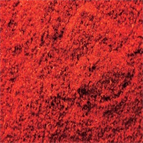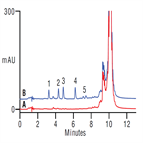Find methods for your needs
Refine by Feature
Displaying 1-5 of 17 results for Tag: Dye
Rapid and sensitive UHPLC screening of food dyes in carbonated beverages using UV/Vis wavelength switching
Instrument Type: UHPLCThe analysis of food dyes in carbonated beverages is important as many of these dyes are either controlled substances or are being phased out in certain countries due to their reported adverse health effects. Being able to identify and quantify food dyes in beverages quickly and with high sensitivity is therefore important. Reversed-phase chromatography is an excellent technique for the analysis of dyes. Many dyes are readily soluble in reversed-phase eluents and have strong visible and UV absorbance properties. This method demonstrates the separation of ten contentious dyes.
Analysis of Illegal Dyes in Food Matrices Using Automated Online Sample Preparation with Liquid Chromatography-Mass Spectrometry
Instrument Type: LCMSMSSudan dyes are red dyes used for coloring solvents, oils, waxes, petrol, or as additives in shoe and floor polish. They have been found in a number of food products such as chili / chili-containing products. Sudan dyes are banned as food additives in the USA, the EU, and many other countries, due to their links to cancer and other negative health effects. To overcome limitations in popular offline SPE and LC-UV measurements, we describe an easy, comprehensive LC method using a Transcend TLX-1 system powered by TurboFlow technology to analyze five illegal dye residues in a variety of sauces.
LC-MS Method Using Cloud Point Extraction for the Determination of Permitted and Banned Azo Colors in Liquid, Semi-liquid and Solid Food Matrices
Instrument Type: LCMSColors are food additives that are regulated in the EU, USA, and China. Only approved food colors can be used and others are banned such as some azo compounds, because of their potential carcinogenicity. In this Method, we describe a new Cloud Point Extraction (CPE) method for determining the presence of approved water soluble and banned fat soluble azo colors, followed by separation on a Thermo Scientific Hypersil GOLD column and detection with a Thermo Scientific MSQ Plus single quadrupole mass spectrometer.
AB107: Determination of Hexavalent Chromium in Dyes
Instrument Type: ICHexavalent chromium [Cr(VI)] is the most toxic form of the metal chromium. Leather products colored with dyes containing trivalent chromium, and sweat can transfer the chromium from the leather to the skin. It is possible that some of the Cr(III) oxidizes to Cr(VI). Leather gloves were found to contain Cr(VI). Here, we analyze two dyes for Cr(VI) using a sensitive ion chromatography (IC) method with postcolumn reaction to produce a colored complex detected by visible absorbance. Also refer to AU 179 for an updated method for Cr(VI) analysis.
Improved analysis of sudan dyes in paprika using a Thermo Scientific Acclaim 120 C18 HPLC column
Instrument Type: HPLCThe Thermo Scientific HPLC system is applied for the analysis of sudan dyes in paprika. The separation is performed on a Thermo Scientific Acclaim 120 C18 HPLC column, with UV detection at 500 nm.





